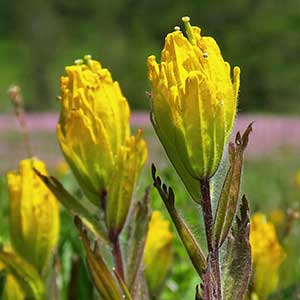Castilleja levisecta
Castilleja cinerea
golden Indian paintbrush, golden paintbrush
ash-gray Indian paintbrush, ash-gray paintbrush
few to many, erect, ± decumbent or creeping at base, unbranched, sometimes branched, hairs spreading, medium length and long, soft, mixed with short stipitate-glandular ones.
several to many, erect to ascending, or decumbent, inflorescence erect in high-elevation form, unbranched, sometimes branched, hairs dense, spreading, ashy gray, short and long, soft, mixed with short stipitate-glandular ones.
green to purple or brown-tinged, linear-lanceolate proximally, oblong-ovate or -obovate distally, 0.8–5.2 cm, not fleshy, margins plane, distalmost sometimes ± wavy, involute, 3–7(–11)-lobed, apex obtuse;
lobes erect to ascending, linear to linear-spatulate, very short, toothlike, usually arising from distal 1/3 of blade, apex rounded.
green, brown, purple, or deep gray, linear or narrowly to broadly lanceolate to sometimes ovate, 0.7–3 cm, not fleshy, margins plane, slightly involute, 0(–3)-lobed, apex acuminate;
lobes ascending to spreading, linear to lanceolate, apex acuminate.
2.5–25 × 1–4 cm;
bracts bright yellow throughout, or proximally greenish, distally bright yellow, sometimes deep yellow-orange, especially with age, oblong, elliptic, or obtuse to ovate, (0–)5–9(–13)-lobed, sometimes wavy-margined;
lobes erect to ascending, oblong, short to medium length, arising above mid length, central lobe apex rounded, lateral ones rounded to acute.
1–8.5 × 2–5 cm;
bracts proximally greenish or deep reddish purple, distally burnt orange, sometimes yellow or deep red to deep burgundy, proximal sometimes lanceolate with narrow lobes, distal or all bracts broadly lanceolate to oblong or slightly oblanceolate, (0–)3–5-lobed, appearing dusty with dense, short stipitate-glandular hairs, many with a nodulose to pillarlike, crystallized, usually pigmented exudate, papillose at 40x;
lobes ascending-spreading, oblong or oblanceolate, short, arising above mid length, central lobe apex rounded, often expanded, rounded, or truncate, lateral ones acute to rounded.
straight or slightly curved, 17–28 mm;
tube 12–15 mm;
beak exserted, adaxially green or greenish yellow, 6–8 mm;
abaxial lip yellow or greenish, reduced, not inflated, 2–3 mm, 25–33(–50)% as long as beak;
teeth ascending to erect, yellow, 0.5–1.5 mm.
straight, 12–18 mm;
tube 9–14 mm;
beak included or tip just barely exserted, adaxially green or pale yellow to deep burgundy, 3–5 mm;
abaxial lip green, burgundy, or reddish purple (in high-elevation form), little inflated, small, included, 2 mm, to 20% as long as beak;
teeth incurved, green, 0.2–0.5 mm.
distally yellow, 13–22 mm;
abaxial and adaxial clefts 4–9.5 mm, 30–40% of calyx length, deeper than laterals, lateral 2.5–4.5 mm, ca. 25% of calyx length;
lobes linear to narrowly oblong or narrowly lanceolate, apex obtuse, sometimes rounded to acute.
colored as bracts, sometimes whitish proximally, 1.5–20 mm (shorter in upper elevation form);
abaxial and adaxial clefts 3.5–8 mm, 30–50% of calyx length, all 4 clefts subequal;
lobes linear to narrowly oblong or oblanceolate, apex obtuse to rounded, densely stipitate-glandular.
= 24.
Castilleja levisecta
Castilleja cinerea
Castilleja levisecta is listed as threatened in the United States and endangered in Canada, where it is extremely rare. Most of its grassland habitat has been altered by development in the Puget Trough, and there are historical stations in the metro areas of what are now Victoria, Portland, and Seattle. For several decades, C. levisecta was considered extirpated from Oregon. However, recent reintroduction programs in Oregon and Washington have been very successful at reestablishing this species at several sites in the Willamette Valley. The bright yellow inflorescences often gradually age to a golden yellow color, unique in the genus.
Castilleja levisecta is in the Center for Plant Conservation’s National Collection of Endangered Plants.
(Discussion copyrighted by Flora of North America; reprinted with permission.)
Castilleja cinerea is endemic to the higher elevations of the San Bernardino Mountains, San Bernardino County. Most plants are upright to ascending and have yellow to yellow-orange inflorescences, with occasional plants ranging to dull red, especially with age. On Sugarloaf Mountain, mostly above 2700 m, is a distinctive form with consistently reddish purple to burgundy inflorescences and a strongly decumbent growth form.
Castilleja cinerea is most often associated with and likely parasitic on Artemisia nova and Eriogonum species. Castilleja cinerea is known from few populations and is threatened by livestock grazing, development, and vehicle use. It is listed as a threatened species under the Endangered Species Act of the United States.
The crystalline exudate associated with the stipitate-glandular pubescence of the distal portion of the bracts is unique in the genus.
(Discussion copyrighted by Flora of North America; reprinted with permission.)


